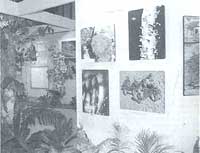Pitching eco messages and washing machines
 DEVELOPMENT does not imply destruction of the environment. This was a message sought to be given by the India International Trade Fair held in the Capital in November. Essentially an exhibition on consumer goods, the fair also featured a section on the environment with examples of eco-friendly products and technologies. It vividly portrayed the degradation of the environment and also focussed on the programmes the government has undertaken to reverse the trend.
DEVELOPMENT does not imply destruction of the environment. This was a message sought to be given by the India International Trade Fair held in the Capital in November. Essentially an exhibition on consumer goods, the fair also featured a section on the environment with examples of eco-friendly products and technologies. It vividly portrayed the degradation of the environment and also focussed on the programmes the government has undertaken to reverse the trend.
The Botanical Survey of India put on show some rare plants, including Psilotum nudum, the most primitive of all vascular plants. Also featured were a seed of an endangered palm (Lodoicea maldivica) restricted to the Seychelles Islands, the pilger or common yew (Taxus baccata) -- the bark of which is being experimented with for cancer remedies -- and the Boj patra (Betula utilis), which was used for writing in ancient India.
Natural heritage The Zoological Survey of India (ZSI) exhibit on animal and marine life drew many school children. Said a ZSI spokesperson, "This is the natural heritage of India. If we continue to destroy it, our future generations will be bereft of this natural legacy."
A section on industry and environment had displays from various companies on a wide range of eco-friendly products and techniques. Coal India Limited set up a simulated coal mine, complete with soot, working miners, machines and conveyor belts carrying coal. The National Thermal Power Corp featured conservation programmes such as creation of green belts around power stations and rehabilitation and vocational training schemes for people displaced by power projects.
The display by the Industrial Toxicology Research Centre of the Council of Scientific and Industrial Research featured safe, cheap and environment-friendly products, concentrating on various water devices used to purify water as well as a portable water analysis kit.
Cost-effective construction The Housing and Urban Development Corp (HUDCO) set up a stall in another part of the fair aimed at promoting the manufacture and use of cost-effective, energy saving building material. The exhibition was organised by HUDCO and managed by the Indus Good Earth Homes and Constructions Limited (IGEHC). Said M N Joglekar, executive director of HUDCO, "The objective was to establish a linkage between environment and appropriate building material."
"The emphasis," said Wilfred Hamrum, founder and chief executive officer of IGEHC, "is on (converting) waste to wealth. We have tried to focus on materials that are also pro-environment".
The stall, which was designed and put up with the assistance of architect Laurie Baker, won the gold medal in the special display category. It featured a miniature house, sections of which were built with various materials such as flyash bricks, pressed soil blocks, compressed concrete blocks and ordinary bricks. The dome-shaped ceiling of the house was made of reinforced cement concrete panels. According to Joglekar, the materials used are of good quality and cost 15 per cent less than other materials.
Development Alternatives, a non-profit organisation that propagates sustainable development, demonstrated the process of making compressed concrete blocks.
Despite the good intentions, an environment section at a fair where the largest draw was household gadgets, toys and consumer durables seemed out of place. Besides, fairs such as this aiming at increasing awareness, should also be held in other parts of the country.
